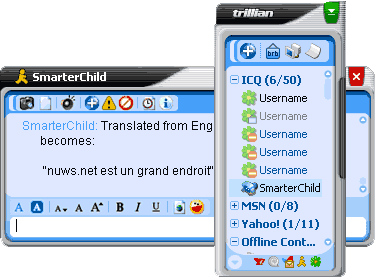
Text
Instant messenger is the easiest and fastest way to communicate. Why do I need more?
Text offers and lacks a few things. Text has been tried and true for years, but not really “true.” I suppose typing text is somewhat faster than talking if one type super fast, but it’s not necessarily easier if you are not adept at typing and have to correct misspellings.
A study was done at the University of Michigan, Ann Arbor to study the basis of trust in a social situation over four mediums: face-to-face, text, audio, and video. It found that “groups meeting over email could not develop enough trust to reach the optimal outcome in a social dilemma, where as groups meeting face-to-face did so easily and quickly” (Bos et all, 291).
Agreed, most people that chat online over instant messenger have likely met each other beforehand. This is why perhaps other mediums such as audio and video are not needed at all. With the additional setup of hardware and correspondence to software, text seems the most easily accessible since a keyboard and program is all that is needed. Popular instant messengers program include AIM, MSN Messenger, and Trillian, which supports a multitude of messenger programs and compresses it into one program.
Email is another issue though. Emails to non-related friends or family become enveloped in this issue of trust. Emails to potential employers and organizations become less human and more digital, especially when the email address is something like jobs@somejob.com. In the same study as above, “groups that interacted via e-mail developed trust if they had a brief face-to-face meeting prior to the experiment.
Indeed, this follows the notion that a sense of human touch or presence is crucial in developing trust. Another study done at the University of Tokyo indicates, “chat systems are far more primitive than face-to-face conversation, making it difficult to convey many basic cues, such as emotions” (Wang, Prendinger, and Igarashi 1171).
But smiley faces convey emotions :D!
A certain aspect of text has manifested to compensate for the lack of emotions: emoticons. Examples include smiley faces, text-made characters, and even onomatopoeias. Here are a few real text examples: =) (happy face), =( (sad face), ^_^ (happy face), o.O (surprised face). Text gets even more complicated when one makes up characters with just text: <(‘-‘<) <( ‘-‘ )> (>’-‘)> (Kirby dance).
“…while it is harder, perhaps, to tell someone is lying when you don’t see them in person, technology is addressing this too, through voice pattern and biometric analyses” (Presnky 4). Such studies were conducted in the University of Tokyo, where animated text, text accompanied with size, speed, and color, was used to determine whether emotions were more appropriately conveyed through something more than just text alone (Wang, Predinger, and Igarashi 1172).
I am convinced that normal text cannot deliver the same feeling as a face-to-face conversation, due to its lack of face-to-face confrontation. To develop trust, there needs to be a level of inter-personal communication, not just information passed on through a medium, such as email or instant messenger. It is easier to just say things than to type it out in words or spend time thinking about how to present something with words.








